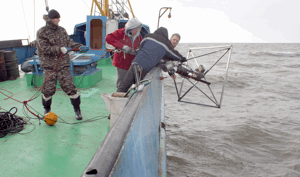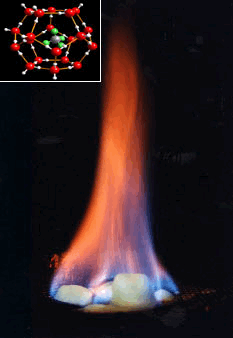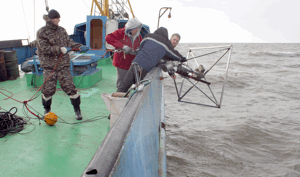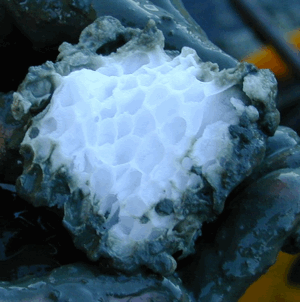Getting to the Bottom of Methane
Air Date: Week of March 12, 2010

Scientists drop a tool in the ocean that allows them to record the sound of methane bubbling up from the seafloor. (Photo: Igor Semiletov, University of Alaska Fairbanks)
Scientists have discovered the permafrost beneath the East Siberian Arctic Shelf is melting, releasing large amounts methane into the atmosphere. Some say it could mean serious climate consequences, others say C02 is still the bigger problem. Host Jeff Young speaks with Dr. Matthew Reagan of the Lawrence Berkeley National Laboratory about the need to answer key questions before sounding the alarm about methane: how much and how fast?
Transcript
YOUNG: It’s Living on Earth, I’m Jeff Young. Recent discoveries on the floor of the Arctic Ocean have raised interest and concern about methane and its role in climate change. A study in the journal Science found permafrost under the East Siberian Arctic Shelf is not so permanent. Some of it is melting and as it does, it leaks methane into the atmosphere. Previous studies found a similar phenomenon in the waters off of Norway.
This raises a troubling scenario, because methane is a powerful greenhouse gas.
If warming waters melt enough of these frozen hydrates of methane, it could lead to a sort of feedback loop amplifying climate change. Dr. Matthew Reagan at the Lawrence Berkeley National Laboratory is working on models of these methane releases.
Welcome to the program.
REAGAN: Hello, Jeff.
YOUNG: So, why are we concerned about these releases of methane from the oceans?
REAGAN: Well, recently scientists have realized that vast quantity of methane that exists in the oceans and in the permafrost in various forms. And as the climate warms the oceans warm in concert and various processes may cause this methane to enter the ecosystem. First, in the oceans, and then possibly into the atmosphere.

Frozen methane on fire. (Courtesy of the United States Geological Survey)
YOUNG: So this most recent study looked at the East Siberian Arctic Shelf, which I guess is fairly shallow water. But that’s not the only spot where scientists are finding this, right?
REAGAN: That’s correct. In fact, about a year and a half ago, an expedition in the Bering Sea Svalbard area found a series of methane plumes erupting from the shallow continental shelf west of the island of Spitsbergen. And what was interesting about these plumes was not only their existence and their size, but that we see plumes erupting out of the sea floor in some 390, 400 meters of water and reaching high up into the water column.
And in the case of the East Siberian Arctic Shelf we also see that the methane is passing through the water column and reaching the atmosphere. Previous studies thought that much of the methane would be oxidized in the oceans and release to the atmosphere would be minor. But now we’re seeing releases that are both large enough and shallow enough to let that methane get into the atmosphere.
YOUNG: Give me a sense of how much methane we’re potentially talking about?
REAGAN: Various numbers have been thrown out, but we estimate that the quantity of methane in gas hydrates exceeds, possibly by a factor of two, all of the carbon in developed and undeveloped fossil fuel reservoirs.

Scientists drop a tool in the ocean that allows them to record the sound of methane bubbling up from the seafloor. (Photo: Igor Semiletov, University of Alaska Fairbanks)
YOUNG: So, do we know that this is a new phenomenon, that it really is melting because the seas are getting warmer, or is this something that maybe has been going on for a long time and we just never noticed it?
REAGAN: You know, we don’t know. In the Bering Sea Svalbard area the region had experienced warming of the ocean in recent times that’s documented. However, these observations have only been made recently. So what we have to do is often supplement these observations with modeling to try to figure out whether these processes have the potential to cause methane release in this form, or if perhaps the methane is not tied to say, recent temperature change and is something that’s been chronic and been happening for awhile.
YOUNG: So tell me about methane as a greenhouse gas. How does it compare to carbon dioxide in its ability to trap heat?
REAGAN: Well, methane, depending on how you assess its impact can be 20 to 40 times as powerful a greenhouse gas as carbon dioxide. However, methane’s residence time in the environment is much less than that of carbon dioxide. Methane oxidizes to carbon dioxide on time scales of decades, while carbon dioxide can be with us for thousands of years.
YOUNG: So, methane: very powerful greenhouse gas, but it doesn’t stick around that long. So the trick then, I guess, is you have to figure out how much of what is getting to that atmosphere all at once.

Methane “ice” pulled from a subduction zone off Oregon. (Photo: Wikimedia Commons)
REAGAN: Yes, both how much can be released to the atmosphere and more importantly, how quickly can it be released to the atmosphere? The key to understanding the effect of methane is knowing the rate of release into the environment. Also to know that rate of release we need to understand the fate of the methane as it’s released.
YOUNG: So if we do get a big burp of methane all at once that might be one of what we call a -- I guess a feedback loop, right?
REAGAN: That is what has been hypothesized and what scientists have been concerned about for many years. When you look at the sheer size of the methane reservoir there is a reason to be concerned. However, I don’t think we should be scared and I don’t think we should be sounding alarms just yet. What we need to do is do the work and study the situation. Scientists are just starting to quantify this.
The observations off of Spitsbergen, the recent discovery in the East Siberian Arctic Shelf, these are key because they are the first real evidence that this release may be happening now, and this is motivating scientists to study the problem even harder.
YOUNG: So if we’re just now starting to get a handle on the mechanism of this potential feedback loop that means that this sort of stuff has not yet been fed into climate modeling for what the impact of climate change might mean?
REAGAN: No, and in fact, our project here at Berkeley Lab in collaboration with Los Alamos and Lawrence Livermore Labs is to track methane from the sediments, from release from hydrates in the sediments up into the ocean water column, study how it affects of ocean chemistry, assess whether that methane can be released into the atmosphere, and if so, how much? This data will all going into climate models and tell us whether methane is truly a concern.
YOUNG: Dr. Matthew Reagan at Lawrence Berkeley National Laboratory. Thank you, sir.
REAGAN: Thank you very much.
Links
For more about recent discoveries of methane releases, click here.
Click here to learn more about methane and climate change.
Living on Earth wants to hear from you!
Living on Earth
62 Calef Highway, Suite 212
Lee, NH 03861
Telephone: 617-287-4121
E-mail: comments@loe.org
Newsletter [Click here]
Donate to Living on Earth!
Living on Earth is an independent media program and relies entirely on contributions from listeners and institutions supporting public service. Please donate now to preserve an independent environmental voice.
NewsletterLiving on Earth offers a weekly delivery of the show's rundown to your mailbox. Sign up for our newsletter today!
 Sailors For The Sea: Be the change you want to sea.
Sailors For The Sea: Be the change you want to sea.
 The Grantham Foundation for the Protection of the Environment: Committed to protecting and improving the health of the global environment.
The Grantham Foundation for the Protection of the Environment: Committed to protecting and improving the health of the global environment.
 Contribute to Living on Earth and receive, as our gift to you, an archival print of one of Mark Seth Lender's extraordinary wildlife photographs. Follow the link to see Mark's current collection of photographs.
Contribute to Living on Earth and receive, as our gift to you, an archival print of one of Mark Seth Lender's extraordinary wildlife photographs. Follow the link to see Mark's current collection of photographs.
 Buy a signed copy of Mark Seth Lender's book Smeagull the Seagull & support Living on Earth
Buy a signed copy of Mark Seth Lender's book Smeagull the Seagull & support Living on Earth

